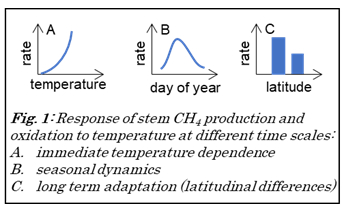研究課題
Temperature sensitivity of tree trunks methane production and emission
樹木幹メタン生成と放出の温度に対する反応性
研究組織
| 代表者 | EPRON Daniel, Kyoto University, Graduate School of Agriculture |
|---|---|
| 共同研究者 | TAKAHASHI Kenshi, Kyoto University, RISH, MOCHIDOME Takumi, Kyoto University, Graduate School of Agriculture OHTAKE Yuuta, Kyoto University, Graduate School of Agriculture |
| 関連ミッション |
|
研究概要
Methane (CH4) emissions by stems of living trees become a major concern due to the increasing contribution of CH4, the most abundant volatile hydrocarbon present in the atmosphere, to the anthropogenic radiative forcing. The role of trees in the global methane budget is still unrecognized. Until recently, trees were considered passive conduits through which CH4 produced in the soil where anaerobic conditions prevail is transferred. In addition to CH4 originating from the soil, CH4 that accumulates in tree stems and emits to the atmosphere is produced endogenously by methanogenic archaea in the heartwood where anaerobic conditions prevail. We recently found that the mcrA gene of methanogenic archaea was amplified from wood samples of several species from the Ashiu forest. Although methanogenesis is temperature dependent like all biological processes involving enzymatic reactions, CH4 emission results from both direct and more complex indirect interactions of microbial and abiotic drivers. Long-term influence of global warming may be driven by changes in substrate availability or changes in the size and composition of CH4-related microbial communities. The objective of this study is to characterize the influence of warming on tree trunks methane production and emission at different time scales.
We will elucidate the response of tree trunks methane production and emission to temperature at different time scales (Fig. 1), from the immediate temperature dependence (A), the seasonal dynamics (B) and the long-term adaptation (C).

Because experimental warming of large trees is not achievable, a time to space substitution approach will be implemented. Trunk CH4 emission will be measured monthly across the growing season from May to November at the Ashiu experimental forest on 6 to 10 trees belonging to 6 species (B).
Immediately after the last measurement of trunk CH4 flux in November, we will sample wood cores. The inner heartwood section will be incubated anaerobically using a mixture of N2, CO2 (10%) and H2 (1%) to determine the potential rate of CH4 production. Incubation will be conducted at four different temperatures, from 5 to 35 °C, to study the temperature dependence of CH4 production (A).
In August, additional CH4 flux measurements and incubations will be conducted in two experimental forests of Hokkaido University (Teshio and Uryu; 44-45°N) on 3 species that are also studied in Ashiu to characterize the long-term adaptation (C).
Microbial DNA will be extracted from inner heartwood immediately after the incubation to quantify the mcrA maker gene for methanogens, in collaboration with microbiologists of Nagoya University.
ページ先頭へもどる
2025年7月14日作成


